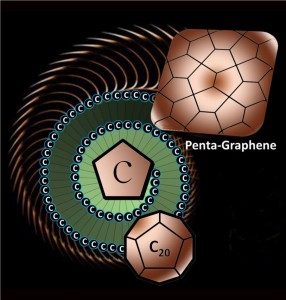
The newly discovered material, called penta-graphene, is a single layer of carbon pentagons that resembles the Cairo tiling, and that appears to be dynamically, thermally and mechanically stable.
Image: VCU
Researchers from Virginia Commonwealth University (VCU) in conjunction with universities in China and Japan have discovered a new structural variant of carbon that they are coining “penta-graphene.”
The new material is comprised of a very thin sheet of pure carbon that is especially unique due to its exclusively pentagonal pattern. Thus far, the penta-graphene appears to be dynamically, thermally and mechanically stable.
“The three last important forms of carbon that have been discovered were fullerene, the nanotube and graphene. Each one of them has unique structure. Penta-graphene will belong in that category,” said the paper’s senior author and distinguished professor in the Department of Physics at VCU, Puru Jena in a press release.
The inspiration for this new development came from the pattern of the tiles found paving the streets of Cairo. Professor at Peking University and adjunct professor at VCU, Qian Wang, got the inspiration that inevitably led to penta-graphene while dining in Beijing.
Wang noticed a piece of artwork on the wall of the restaurant she was dining in and had a moment of revelation. The artwork depicted the streets of Cairo, and Wang immediately thought of the uniqueness of the pattern.
Because the pattern was composed of only pentagons, she hypothesized that if created in a lab, it would be stable.
This from VCU:
The researchers simulated the synthesis of penta-graphene using computer modelling. The results suggest that the material might outperform graphene in certain applications, as it would be mechanically stable, possess very high strength, and be capable of withstanding temperatures of up to 1,000 degrees Kelvin.
Penta-graphene diverges from traditional graphene in the sense that it is a semiconductor, whereas graphene is a conductor. The material also stretches, which the researchers say is unusual.
The next step for the researchers is to synthesize the penta-graphene.
Interested in graphene? Make sure to check out the 227th ECS Meeting in Chicago this May, where we will be hosting the “Graphene and Beyond: 2D Materials” symposium.
But while you’re waiting for that meeting, head over to the Digital Library and read all the latest papers on graphene.


